Magnapinna pacifica
Pacific bigfin squid
Michael Vecchione and Richard E. YoungIntroduction
Magnapinna pacifica, the type species of the family, was originally described from three individuals (two juveniles about 50 mm ML and a paralarva of 19 mm ML) from the North Pacific. Recently a fourth specimen has been captured from the Gulf of Mexico, Atlantic Ocean. A brief description of the latter specimen can be seen here.
Brief diagnosis:
A Magnapinna with ...
- proximal-tentacles wider than adjacent arms.
- numerous suckers on proximal-tentacles.
Characteristics
- Arms.
- Proximal-arm suckers biserial at base, in 3 to 4 series distally.
- Distal-arms vermiform.
- Inner sucker rings probably smooth.
- Tentacles.
- Proximal-tentacles short, thicker than adjacent arms.
- Proximal-tentacle suckers small, in approximately eight series except near base.
- Basal one or two tentacle suckers enlarged relative to following suckers.
Figure. Left - Oral view of the brachial crown of M. pacifica, holotype, showing sucker arrangement on proximal portion of the proximal-tentacles. Note the enlarged suckers at the tentacle base. Right - Oral view of the distal region of the proximal-tentacle of the holotype. Photographs by M. Vecchione.
- Sucker dentition unknown.
- Distal-tentacles vermiform.
 Click on an image to view larger version & data in a new window
Click on an image to view larger version & data in a new window
Figure. Filaments of M. pacifica, holotype, 51 mm ML . Left - Lateral view of tentacle-club. Middle - Oral view of distal region of proximal-tentacle. Drawing from Vecchione and Young (1998). Right - Dorsal view of head and brachial crown. Photographs by R. Young.
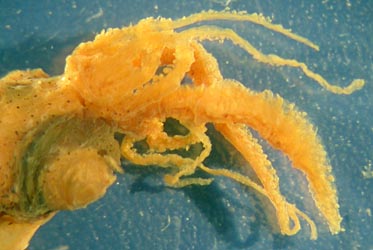
Figure. Dorsolateral view of the head and brachial crown of M. pacifica, Berry specimen. This specimen had dried out and has been reconstituted. Note the large, broad tentacles and the elongate filaments of the arms which bear suckers in this, presumably, older individual.
- Head
- Large eyes occupy most of head.
- Large eyes occupy most of head.
- Funnel
- Funnel locking-apparatus with oval depression.
- Fins
- Fins very large: Length equal to or greater than squid length from posterior tip of muscular mantle to tip of tentacles.
- Fins terminal.
- Width approximates length.
- Photophores
- Photophores absent.
- Photophores absent.
- Measurements, mm
Holotype Berry specimen Atlantic specimen Mantle length 51 49 51 Muscular mantle length 16 17 18 Gladius length* 53 52 52* Fin length 39 40 47 Fin width 34 41 38 Head length 5 4 4 Head width 7 5 6 Eye diameter 4 3 4 Arm I, left/right, to terminal sucker 2.3 / 2.4 - - / 3.4 Arm II, left/right, to terminal sucker 3.9 / 3.5 - 4.1 / 3.8 Arm III, left/right, to terminal sucker 2.9 / 2.7 - - / 3.8
Arm IV, left/right, to terminal sucker 4.8 / 4.8 - - / 3.8 Tentacle, left/right, to terminal sucker 7.1 / 7.4 - 7.4 / 7.0 Arm I, left/right, terminal filament length 2+ / 1.3+ - - Arm II, left/right, terminal filament length 2+ / 2.6 - - Arm III, left/right, terminal filament length 2.6+ / 2.9 - - Arm IV, left/right, terminal filament length 2.0 / 1.3+ - - Tentacle, left/right, terminal filament length 2.2 / - - -
Comments
M. pacifica is very different from M. atlantica and its close relatives. (1) M. pacifica has much broader proximal- tentacles than proximal-arms while the M. atlantica group of species has much narrower proximal-tentacles than proximal-arms. (2) M. pacifica has proximal-tentacles that are covered with numerous suckers while the M. atlantica group has proximal-tentacles that carry only a few or no suckers. (3) M. pacifica has proximal-arm suckers in three or four series distally while the M. atlantica group has proximal-arm suckers in two series. (4) M. pacifica, unlike M. atlantica but not other members of the group, lacks glandular regions on their proximal-tentacles.
Life History
Only a single paralarva is known. It has the following characteristics:- Arms
- Arms short, with suckers in 3-4 series at bases of arms III and IV; otherwise in two series.
- Arm tips bare and attenuate.
- Tentacles
- Tentacles short, broad.
- Suckers in 7-8 series distally, grades into buds.
- Fins
- Muscular mantle overlaps anterior of fins by 15% of fin length.
- Fins extend onto a tail posteriorly.
Figure. Paralarvae of M. pacifica. Left - Ventral and dorsal views, 19.1 mm ML, Hawaiian waters. Middle - Dorsal view of head of same paralarva. Right - Tentacle of same paralarva. Drawings from Vecchione and Young (1998), modified.
Distribution
The holotype was taken off the California coast at a depth between 0 and 200m in a Bongo plankton net. The other juvenile was found in the stomach of the lancet fish Alepisaurus ferox and the paralarva was taken off Hawaii at a depth between 0 and 300 m in a 4 m2 plankton net. The Atlantic specimen was taken from the Gulf of Mexico in a 3 m2 opening/closing Tucker traw at a depth of 150-300 m over a bottom of 3613 m during 1700-2000 hrs.
The capture localities are:
- Holotype, 51 mm ML: 33° 49'N, 121° 51'W.
- Juvenile, 49 mm ML; 30° 22'N, 129° 45'W.
- Paralarva, 19.1 mm ML; 21° 20'N, 158° 20'W.
- Atlantic specimen, 51 mm ML: 26°52'N, 85°52"W.
References
Vecchione, M. and R. E. Young. 1998. The Magnapinnidae, a newly discovered family of oceanic squids (Cephalopoda; Oegopsida). South African Journal of Marine Science, 20: 429-437.
Title Illustrations

About This Page

National Museum of Natural History, Washington, D. C. , USA
Richard E. Young

University of Hawaii, Honolulu, HI, USA
Page copyright © 1998 and Richard E. Young
- Content changed 08 February 2007
Citing this page:
Vecchione, Michael and Young, Richard E. 2007. Magnapinna pacifica . Pacific bigfin squid. Version 08 February 2007 (under construction). http://tolweb.org/Magnapinna_pacifica/19449/2007.02.08 in The Tree of Life Web Project, http://tolweb.org/




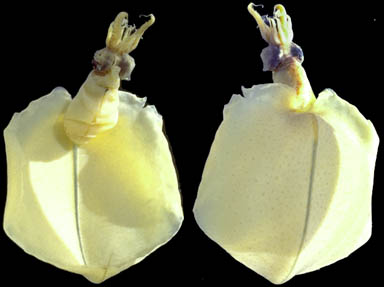
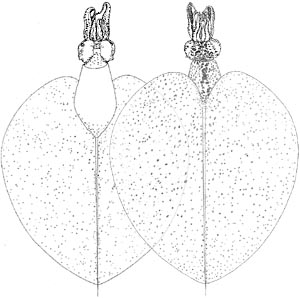
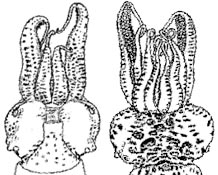
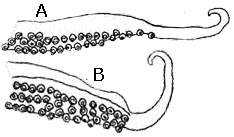
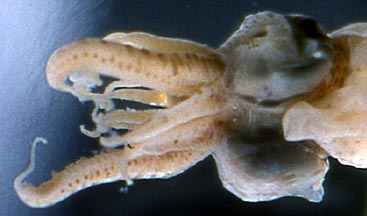

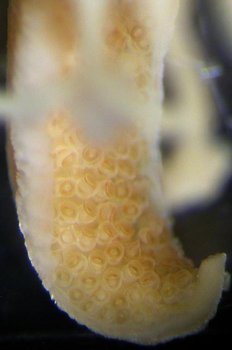
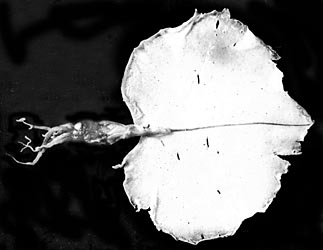
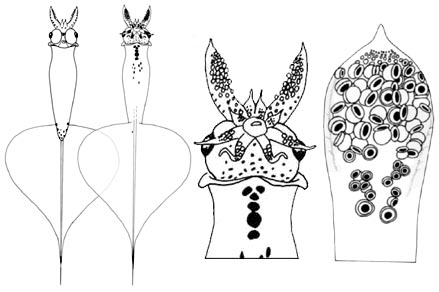
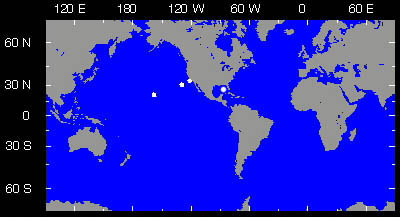




 Go to quick links
Go to quick search
Go to navigation for this section of the ToL site
Go to detailed links for the ToL site
Go to quick links
Go to quick search
Go to navigation for this section of the ToL site
Go to detailed links for the ToL site